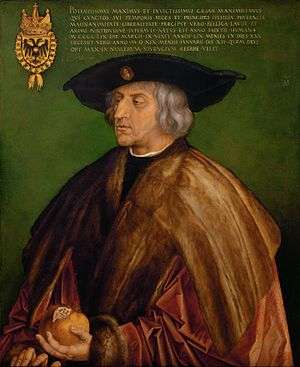Order of St. George (Habsburg-Lorraine)
The Imperial and Royal Order of Saint George or simply Order of Saint George (German: St. Georgs-Orden – Ein europäischer Orden des Hauses Habsburg-Lothringen[1]) is a dynastic order of chivalry and thus a house order of the House of Habsburg, the former Imperial and Royal House of the Holy Roman Empire, the Habsburg Monarchy, the Empire of Austria, the Austro-Hungarian Monarchy, the Kingdom of Hungary, the Crown lands of Bohemia and Croatia and further nations.
| Imperial and Royal Order of Saint George | |
|---|---|
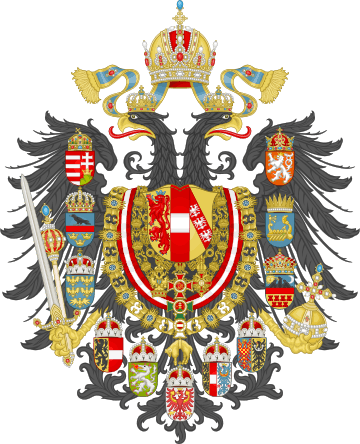 | |
| Awarded by The Head of the House of Habsburg | |
| Type | Dynastic order |
| Established | 30 April 2011 |
| Royal house | House of Habsburg |
| Religious affiliation | Roman Catholic |
| Sovereign | Archduke Karl |
| Grand Master | Archduke Georg |
| Precedence | |
| Next (higher) | Order of the Golden Fleece |
Ribbon of the order | |
It is a European and non-partisan order, which supports the transnational idea of Mitteleuropa (Habsburg definition) and increased need for cooperation between the countries of Central and Southeastern Europe. It is committed to Christianity and a united self-confident Europe. It has approximately 600 knights and Commanderies in Austria, Croatia, Czech Republic, Germany, Hungary, Italy, Netherlands, Serbia, Slovenia, Switzerland and the United Kingdom. The order has women and men as members.[2]
The order represents the centuries-old Habsburg principle of "live and let live" in relation to ethnic groups, peoples, minorities, religions, cultures and languages.[3][4]
The motto of the order is "Viribus Unitis".
Patron saint
The patron saint of the order is St. George as a symbol of chivalry.
Principle
The order is non-profit and fights the eightfold misery like illness, abandonment, homelessness, hunger, lovelessness, guilt, indifference and unbelief.
The Order of St. George venerates St. George as the patron saint of chivalry, while cultivating chivalry and a chivalrous outlook on life.
History
The origins of today's Order of St. George, a European order of the House of Habsburg-Lorraine, go back to 1308. Emperor Henry VII donated the "Order of the Old Nobility" (or later "Order of the Four Roman Emperors"), which can be regarded as the predecessor of today's order. The "Order of the Old Nobility" developed differently over the centuries after its foundation and had experienced heyday and decline.
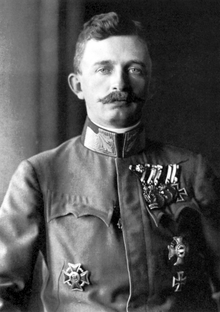
The order also has traditional roots in the Austrian Order of St. George, which was founded by Emperor Friedrich III. of Habsburg and Pope Paul II in Rome in 1469. The headquarters were the former Benedictine monastery Millstatt, the second headquarters was Wiener Neustadt. Emperor Maximilian of Habsburg was a particular patron of the order. It is believed that the Order of St. George by Emperor Friedrich III was connected to another previous order, the "Austrian Dragon Society" founded in 1409 in Ödenburg, which in turn was directly connected to the Order of the Dragon by the Hungarian King and Emperor Sigismund.
The sovereignty of the Order of St. George or the St. George Knights Brotherhood, which was also founded by Emperor Maximilian I, has remained with the House of Habsburg-Lorraine to this day. Emperor Maximilian I tried to promote his St. George's associations and use them politically. On November 15, 1494, for example, he made an appeal to all Christian kings and princes, as well as to all Christianity, to join the Brotherhood and to support a Turkish campaign planned by the emperor for the following year, but without finding much interest. He gave the knights who would take part in this campaign the privilege of wearing a crown in their coat of arms and thus created the status of the "crowned knight".[5]
Empress Maria Theresa is said to have issued new statutes of the order in 1765.
Emperor Franz Joseph I confirmed the priory of the Order of St. George in Austria in 1848.
In 1917 Emperor Charles I confirmed the order as a purely secular order of knights in the future.[6]
Between 1919 and 1920 the order structures were modernized by persons approved by the emperor. Due to the situation in exile of the imperial family, the leadership of the order then went to Prince Johannes of Liechtenstein, although the title of protector and holder of the order remained with the House of Habsburg.
Then there was a need to adapt the statutes of the order to modern conditions. On February 7, 1926, a constitutional reorganization council in Hanover issued a new order, whereby the nobility was no longer required for admission and the order was given the name "Old St. George Knightly Order, also known as the Order of the Four Roman Emperors". The order continued to claim that the unity and interests of the Central European peoples and nations were guaranteed for centuries by the Holy Roman Empire and the Habsburg monarchy.
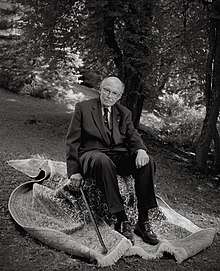
In 1935, due to the political situation in the German Reich, the seat of the order was moved to Salzburg, from where he stood up against National Socialism, for Central Europe independent of Nazi Germany and for the re-establishment of the House of Habsburg. In 1938, after the annexation of Austria, the order was banned and dissolved by the Nazis for political reasons.[7] Many who campaigned for Habsburg during the Nazi era were killed, taken to a concentration camp, or persecuted by the Gestapo. Most of this imperial resistance fighters, such as Heinrich Maier, who successfully passed on production sites and plans for V-2 rockets, Tiger tanks and aircraft to the Allies, or Karl Burian who planned to blow up the Gestapo headquarters in Vienna, were badly tortured and executed.[8][9][10]
The House of Habsburg was an early supporter of European integration and a vehement opponent of National Socialism and Communism.[11] During communism, former members of the order or other Habsburg supporters were persecuted behind the Iron Curtain. The Communists and Socialists as well as the USSR were strictly anti-Habsburg because they feared opposition in their oppressed countries. The Habsburg family played a leading role in the fall of the Iron Curtain.[12][13]
The cancellation of the "Old Order of St. George" (also called "Order of the Four Roman Emperors") by Nazi Germany in 1935/1938 was reversed by the reorganization convention on January 18, 2008. Because after the fall of the Iron Curtain and due to the complete independence of the new Central European countries from the USSR, there was now the possibility and need to reactivate communities in order to connect the peoples in this area. Archduke Otto von Habsburg, Archduke Karl von Habsburg and Prince Vincenz of Liechtenstein were significantly involved.
At the convent on April 30, 2011, Archduke Karl von Habsburg confirmed the “St. Order of George - A European order of the House of Habsburg-Lorraine" as an order of the House of Habsburg. Building on the centuries-old Habsburg motto " Viribus Unitis", the peoples and nations of Central Europe should now take care of their interests together. In the framework of this European Habsburg Order, the historical connections are to be strengthened and expanded, also in order to be able to perform better in United Europe. The Order sees it as its task to recognize and preserve the common cultural, scientific and interpersonal heritage of Central Europe.[14] The model is the tolerant Habsburg approach to the national diversity of the peoples of Central Europe.[15][16][17]
The members of the order should also use those Habsburg roots that extend beyond Central Europe, for example to Italy, Switzerland, Spain, France, Great Britain, Germany, the Benelux countries and the Orient. Accordingly, the “St. Order of George - A European order of the House of Habsburg-Lorraine" has a close relationship with the "Austrian pilgrim hospice for the Holy Family" in Jerusalem, which was donated by Emperor Franz Joseph I for all people of the Habsburg monarchy.[18]
Regarding the necessary moral attitude of a St. Georg knight today, Bishop Klaus Küng said during an investiture in Budapest: "When it comes to values that are of great importance to human development, it is necessary to stand up for them courageously. What are these values? - Ultimately, it's Christian values." But that also means that the order in Habsburg tradition is particularly dedicated to the peaceful balance between religions and the intercultural encounter between Christianity, Judaism[19] and Islam[20].[21]
In addition to local meetings, the order has major events such as in Vienna, Budapest, Prague, Zagreb, Ljubljana, Trieste, Milan, London, Frankfurt, Salzburg and Tyrol.
The admission was and is a special privilege and a great honor.
.png)
Notable members






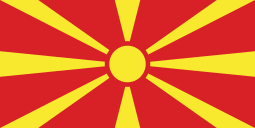



















Source: Ehrenritter
References
- "St. Georgs-Orden Geschichte". georgsorden.at. Retrieved 18 November 2019.
- "Die Ordensregierung". georgsorden.at. Retrieved 14 June 2018.
- For the ability of the Habsburg monarchy to protect and promote the diversity of its peoples and minorities, see: Pieter M. Judson "The Habsburg Empire. A New History" (Harvard University Press 2016).
- For more information on these Habsburg principles, see in particular: Christopher Clark "The Sleepwalkers" (New York 2012).
- Manfred Hollegger "Maximilian I." (2005), p 150.
- Roman Procházka "Österreichisches Ordenshandbuch" (1979), p 274.
- Johannes Krejci "Aus der Geschichte des Alten Ordens vom St. Georg.", Wien 2002.
- Elisabeth Boeckl-Klamper, Thomas Mang, Wolfgang Neugebauer "Gestapo-Leitstelle Wien 1938–1945." Vienna 2018, p 299–305.
- Hans Schafranek "Widerstand und Verrat: Gestapospitzel im antifaschistischen Untergrund." Vienna 2017, p 161–248.
- Peter Broucek "Die österreichische Identität im Widerstand 1938–1945" (2008), p 163.
- Timothy Snyder "The Red Prince: The Secret Lives of a Habsburg Archduke" (2008); James Longo "Hitler and the Habsburgs: The Fuhrer's Vendetta Against the Austrian Royals" (2018).
- Wolfgang Mueller "Die sowjetische Besatzung in Österreich 1945-1955 und ihre politische Mission" (German - "The Soviet occupation in Austria 1945-1955 and its political mission"), 2005, p 24.
- Otmar Lahodynsky: Paneuropäisches Picknick: Die Generalprobe für den Mauerfall (Pan-European picnic: the dress rehearsal for the fall of the Berlin Wall - German), in: Profil 9 August 2014; Thomas Roser: DDR-Massenflucht: Ein Picknick hebt die Welt aus den Angeln (German - Mass exodus of the GDR: A picnic clears the world) in: Die Presse 16 August 2018.
- Regarding the Habsburg tradition in this regard: Moritz Csaky "Pluralité culturelle et identité: Criteres d´ une auto-reconnaissance transnationale sous la Monarchie des Habsbourg" Les Temps Modernes 48:550 (1992), p 154.
- Paul Miller-Melamed and Claire Morelon "What the Hapsburg Empire Got Right" in New York Times, 10 September 2019.
- Johannes Feichtinger, Gary B. Cohen "Understanding multiculturalism: The Habsburg central European experience" (2014).
- William M. Johnston, "The Political and Cultural Background of Vienna 1900: A Golden Age of Cultural Exchange" (Melbourne 2011).
- Austrian Pilgrim Hospice to the Holy Family in Jerusalem
- The House of Habsburg already vehemently opposed anti-Semitism in the 19th century. For example, Emperor Franz Joseph I said: Anti-Semitism should be exterminated. See in detail: Robert S. Wistrich "Die Juden Wiens im Zeitalter Kaiser Franz Josephs - The Jews of Vienna in the Age of Franz Joseph" (Oxford 1994), p 149.
- As early as 1912 (- through the annexation of Bosnia and Herzegovina under state law in 1908, 600,000 Muslims belonged to the k.u.k. Monarchy) was the guarantee of free and public religious practice of the Muslims regulated in the Habsburg monarchy. Bosnian Muslims got the highest Awards for bravery and loyalty and provided the bodyguard of the emperor. European military pastoral care between Christianity, Islam and secularization - Austrian Armed Forces
- On Habsburg and the diversity of religions: Pieter M. Judson "The Habsburg Empire. A New History" (Harvard 2016).
External links
- History of the former National Order and the current Chartered Dynastic Order
- Official website
- Facebook Page
